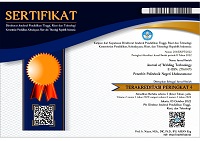Analisa pengaruh variasi arus pengelasan GTAW pada baja AISI 1050 terhadap sifat fisik dan mekanis
Abstract
Analysis of the effect of variations in welding current GTAW on AISI 1050 steel on physical and mechanical properties, the aim of research is to determine the stress strength, strain and see to determine the character or treatment of AISI 1050 steel. The welding process is closely related to defects that affect its mechanical properties. In this study, the welding process was carried out under the hands of the IASI 1050 material with a thickness of 12 mm with an AWS ER70S-6 electrode with a diameter of 1.2 mm with a current variation of 110 amperes, 120 amperes and 130 amperes with tests carried out are tensile and microstructure testing. From the results of the tensile test, it can be concluded that the tensile stress on the 110 amper specimen is 83.34 kgf/mm2, and the tensile voltage at 120 amperes is 43.45 kgf / mm2, and the tensile voltage at 130 amperes is 67, 97 kgf/mm2 that the higher the welding current, the more ductile the tensile strength value and the greater the welding current, the rougher the surface metallography results.
Keywords
Full Text:
PDFReferences
Dadang, Teknik Las GTAW. Jakarta: Direktorat Jendral Peningkatan Mutu Pendidik dan Tenaga Kepenidikan, 2013.
A. Rahmatika, S. Ibrahim, M. Hersaputri, and E. Aprilia, “Studi pengaruh variasi kuat arus terhadap sifat mekanik hasil Pengelasan GTAW alumunium 1050 dengan filler ER 4043,” J. Polimesin, vol. 17, no. 1, pp. 47–54, 2019.
A. Azwinur, M. Yudi, and Z. Zulkifli, “Pengaruh media pendingin terhadap kekerasan dan ketangguhan hasil pengelasan material AISI 1050 pada proses las MAG,” J. POLIMESIN, vol. 18, no. 2, pp. 124–130, 2020.
A. Aditia, N. Nurdin, and A. S. Ismy, “Analisa kekuatan sambungan material AISI 1050 dengan ASTM A36 dengan variasi arus pada proses pengelasan SMAW,” J. Weld. Technol., vol. 1, no. 1, pp. 1–4, 2019.
A. K. Singh, V. Dey, and R. N. Rai, “Techniques to improveweld penetration in TIG welding (A review),” Mater. Today Proc., vol. 4, no. 2, pp. 1252–1259, 2017.
T. Endramawan, E. Haris, F. Dionisius, and Y. Prinka, “Aplikasi Non Destructive Test Penetrant Testing (Ndt-Pt) Untuk Analisis Hasil Pengelasan Smaw 3g Butt Joint,” JTT (Jurnal Teknol. Ter., vol. 3, no. 2, pp. 44–48, 2017.
A. Azwinur, S. Syukran, and H. Hamdani, “KAJI SIFAT MEKANIK SAMBUNGAN LAS BUTT WELD DAN DOUBLE LAP JOINT PADA MATERIAL BAJA KARBON RENDAH,” SINTEK J. J. Ilm. Tek. Mesin, vol. 12, no. 1, pp. 9–16, Jun. 2018, doi: 10.24853/SINTEK.12.1.9-16.
Syahrani, Awal Mustafa, and Oktavianus, “PENGARUH VARIASI ARUS PENGELASAN GTAW TERHADAP SIFAT MEKANIS PADA PIPA BAJA KARBON ASTM A 106 Abstract : The Influence of GTAW Welding Current Variation on Mechanical,” vol. 8, no. 1, pp. 721–729, 2017.
N. Jeyaprakash, A. Haile, and M. Arunprasath, “The parameters and equipments used in TIG welding: A review,” Int. J. Eng. Sci., vol. 4, no. 2, pp. 11–20, 2015
DOI: http://dx.doi.org/10.30811/jowt.v3i1.2026
Refbacks
- There are currently no refbacks.

This work is licensed under a Creative Commons Attribution-ShareAlike 4.0 International License.
Ciptaan disebarluaskan di bawah Lisensi Creative Commons Atribusi-BerbagiSerupa 4.0 Internasional.
Mailing Address:
Politeknik Negeri Lhokseumawe
Jl. Banda Aceh-Medan
Km. 280,3, Buketrata, Mesjid Punteut, Blang Mangat,
Kota Lhokseumawe, 24301
Propinsi Aceh,
Indonesia























